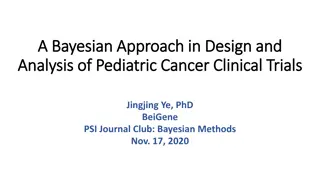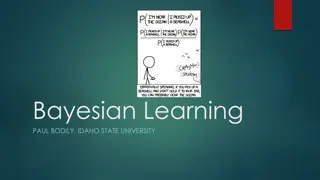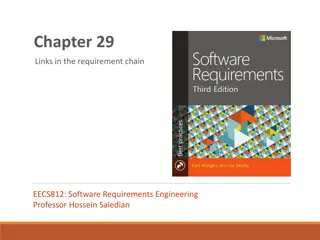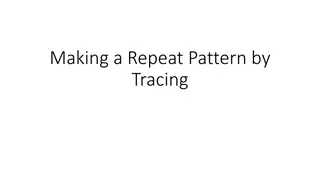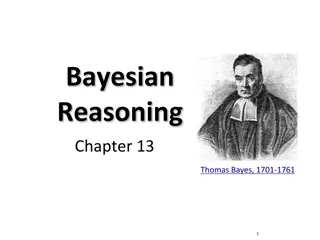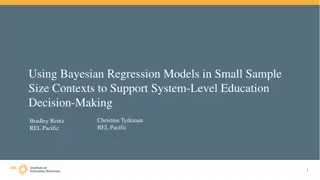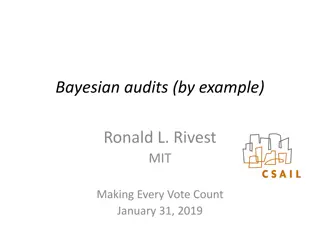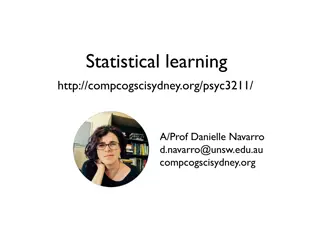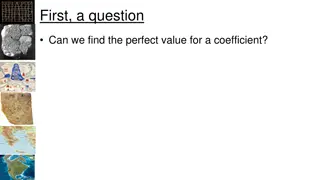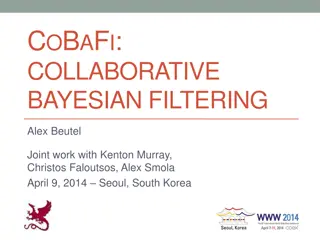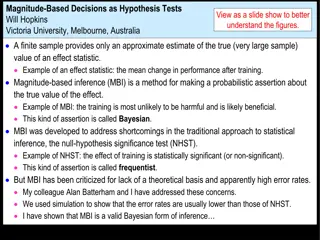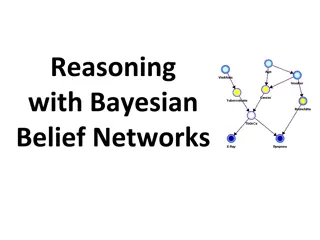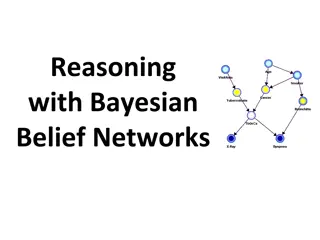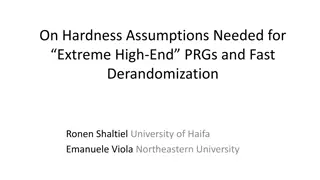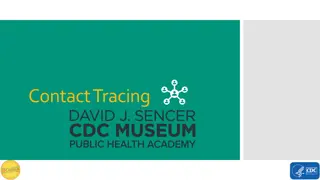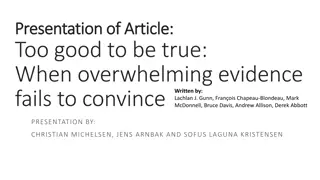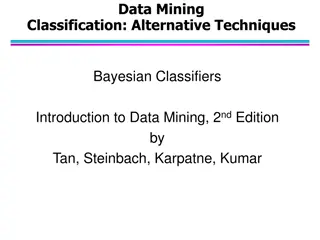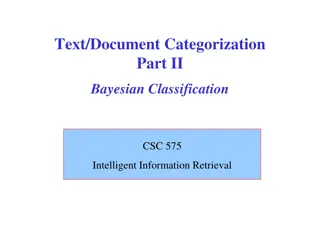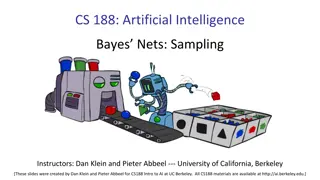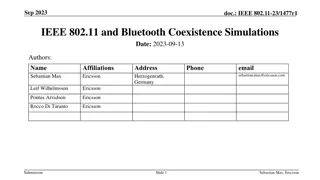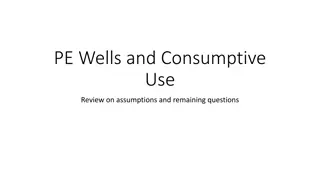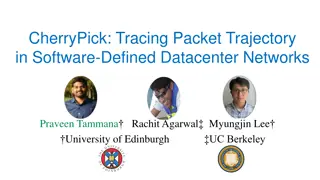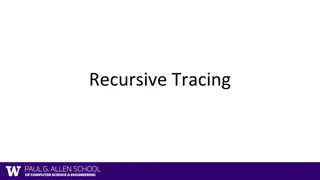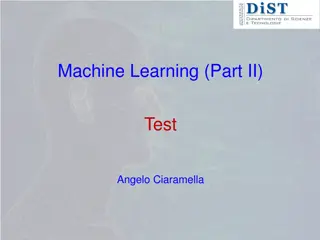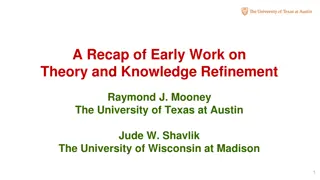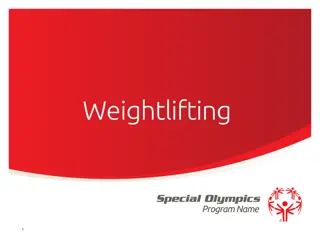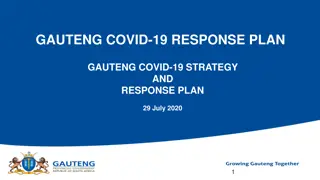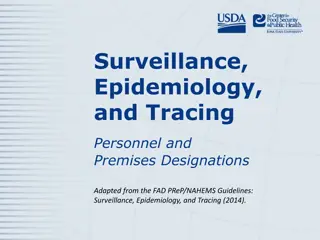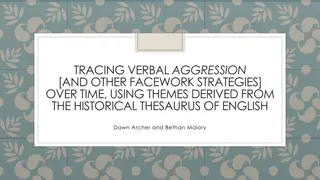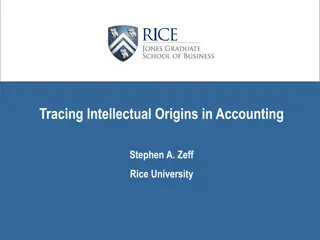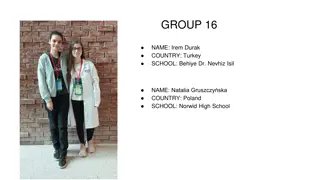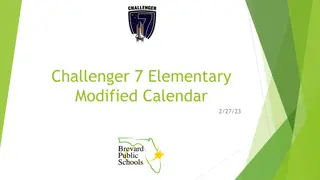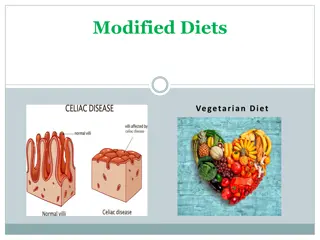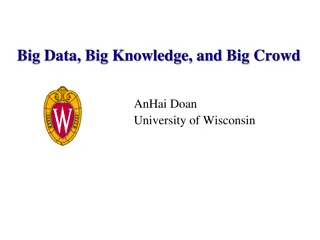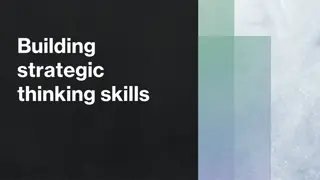Enhancing Bayesian Knowledge Tracing Through Modified Assumptions
Exploring the concept of modifying assumptions in Bayesian Knowledge Tracing (BKT) for more accurate modeling of learning. The lecture delves into how adjusting BKT assumptions can lead to improved insights into student performance and skill acquisition. Various models and methodologies, such as conditionalizing help and moment-by-moment learning, are discussed, highlighting the potential for enhancing educational assessment and evaluation techniques.
- Bayesian Knowledge Tracing
- Learning Models
- Skill Acquisition
- Educational Assessment
- Modified Assumptions
Download Presentation

Please find below an Image/Link to download the presentation.
The content on the website is provided AS IS for your information and personal use only. It may not be sold, licensed, or shared on other websites without obtaining consent from the author. Download presentation by click this link. If you encounter any issues during the download, it is possible that the publisher has removed the file from their server.
E N D
Presentation Transcript
Week 4 Video 5 Knowledge Inference: Modifying BKT assumptions
Friendly Warning This lecture is going to get mathematically intense by the end You officially have my permission to stop this lecture mid-way
BKT has strong assumptions One of the key assumptions is that parameters vary by skill, but are constant for all other factors What happens if we remove this assumption?
BKT with modified assumptions Conditionalizing Help or Learning Contextual Guess and Slip Moment by Moment Learning Modeling Transfer Between Skills
Beck, Chang, Mostow, & Corbett 2008 Beck, J.E., Chang, K-m., Mostow, J., Corbett, A. (2008) Does Help Help? Introducing the Bayesian Evaluation and Assessment Methodology. Proceedings of the International Conference on Intelligent Tutoring Systems.
Note In this model, help use is not treated as direct evidence of not knowing the skill Instead, it is used to choose between parameters Makes two variants of each parameter One assuming help was requested One assuming that help was not requested
Beck et al.s (2008) Help Model p(T|H) p(T|~H) Not learned Learned p(L0|H), p(L0|~H) 1-p(S|~H) p(G|~H), p(G|H) 1-p(S|H) correct correct
Beck et al.s (2008) Help Model Parameters per skill: 8 Fit using Expectation Maximization Takes too long to fit using Brute Force
Note This model did not lead to better prediction of student performance But useful for understanding effects of help
Related Work: Salamin et al. (2021) Applied BKT to a learning system with both videos and problem-solving If student got a wrong answer, they were given a video Salamin and colleagues let P(T) vary based on which video student got Used to determine which videos were more/less effective
BKT with modified assumptions Conditionalizing Help or Learning Contextual Guess and Slip Moment by Moment Learning Modeling Transfer Between Skills
Contextual Guess-and-Slip Baker, R.S.J.d., Corbett, A.T., Aleven, V. (2008) More Accurate Student Modeling Through Contextual Estimation of Slip and Guess Probabilities in Bayesian Knowledge Tracing. Proceedings of the 9th International Conference on Intelligent Tutoring Systems, 406-415.
Contextual Guess and Slip model p(T) Not learned Learned p(L0) p(G) 1-p(S) correct correct
Contextual Slip: The Big Idea Why one parameter for slip For all situations For each skill When we can have a different prediction for slip For each situation Across all skills
In other words P(S) varies according to context For example Perhaps very quick actions are more likely to be slips Perhaps errors on actions which you ve gotten right several times in a row are more likely to be slips
Contextual Guess and Slip model Guess and slip fit using contextual models across all skills Parameters per skill: 2 + (P (S) model size)/skills + (P (G) model size)/skills
How are these models developed? Take an existing skill model Label a set of actions with the probability that each action is a guess or slip, using data about the future Use these labels to machine-learn models that can predict the probability that an action is a guess or slip, without using data about the future Use these machine-learned models to compute the probability that an action is a guess or slip, in knowledge tracing 1. 2. 3. 4.
2. Label a set of actions with the probability that each action is a guess or slip, using data about the future Predict whether action at time N is guess/slip Using data about actions at time N+1, N+2 This is only for labeling data! Not for use in the guess/slip models
2. Label a set of actions with the probability that each action is a guess or slip, using data about the future The intuition: If action N is right And actions N+1, N+2 are also right It s unlikely that action N was a guess If actions N+1, N+2 were wrong It becomes more likely that action N was a guess I ll give an example of this math in few minutes
3. Use these labels to machine-learn models that can predict the probability that an action is a guess or slip Features distilled from logs of student interactions with tutor software Broadly capture behavior indicative of learning Selected from same initial set of features previously used in detectors of gaming the system (Baker, Corbett, Roll, & Koedinger, 2008) off-task behavior (Baker, 2007)
3. Use these labels to machine-learn models that can predict the probability that an action is a guess or slip Linear regression Did better on cross-validation than fancier algorithms One guess model One slip model
4. Use these machine-learned models to compute the probability that an action is a guess or slip, in knowledge tracing Within Bayesian Knowledge Tracing Exact same formulas Just substitute a contextual prediction about guessing and slipping for the prediction-for- each-skill
Contextual Guess and Slip model Effect on future prediction: very inconsistent Much better on Cognitive Tutors for middle school, algebra, geometry (Baker, Corbett, & Aleven, 2008a, 2008b) Much worse on Cognitive Tutor for genetics (Baker et al., 2010, 2011) and ASSISTments (Gowda et al., 2011)
But predictive of longer-term outcomes Average contextual P(S) predicts post-test (Baker et al., 2010) shallow learners (Baker, Gowda, Corbett, & Ocumpaugh, 2012) college attendance several years later (San Pedro et al., 2013) Higher P(S) means lower college attendance, once you control for student knowledge STEM major several years later (San Pedro et al., 2013) Higher P(S) means lower probability of STEM major, once you control for student knowledge
What does P(S) mean? Carelessness? (San Pedro, Rodrigo, & Baker, 2011) Maps very cleanly to theory of carelessness in Clements (1982) Shallow learning? (Baker, Gowda, Corbett, & Ocumpaugh, 2012) Student s knowledge is imperfect and works on some problems and not others, so it appears that the student is slipping
KT-IDEM (Pardos & Heffernan, 2011) Rather than having a single P(G) and P(S) for each skill Each item has its own P(G) and P(S)
LFKT (Khajah et al., 2014) Rather than having a single P(G) and P(S) for each skill Guess and slip are contextually adjusted based on Skill Item Student (past performance on other skills)
FAST+item (Gonzalez-Brenes et al., 2014) Substitutes logistic regression equations for the 4 parameters of Bayesian Knowledge Tracing With coefficients for each skill And coefficients for each item Better prediction of student correctness than traditional BKT or PFA
BKT with modified assumptions Conditionalizing Help or Learning Contextual Guess and Slip Moment by Moment Learning Modeling Transfer Between Skills
Moment-By-Moment Learning Model Baker, R.S.J.d., Goldstein, A.B., Heffernan, N.T. (2011) Detecting Learning Moment-by- Moment. International Journal of Artificial Intelligence in Education, 21 (1-2), 5-25.
Moment-By-Moment Learning Model (Baker, Goldstein, & Heffernan, 2010) Probability you Just Learned p(J) p(T) Not learned Learned p(L0) p(G) 1-p(S) correct correct
P(J) P(T) = chance you will learn if you didn t know it P(J) = probability you JustLearned P(J) = P(~Ln^ T)
P(J) is distinct from P(T) For example: P(Ln) = 0.1 P(T) = 0.6 P(J) = 0.54 P(Ln) = 0.96 P(T) = 0.6 P(J) = 0.02 Learning! Little Learning
Labeling P(J) Based on this concept: The probability a student did not know a skill but then learns it by doing the current problem, given their performance on the next two. P(J) = P(~Ln^ T | A+1+2 ) *For full list of equations, see Baker, Goldstein, & Heffernan (2011)
Breaking down P(~Ln^ T | A+1+2 ) We can calculate P(~Ln^ T | A+1+2 ) with an application of Bayes theorem P(A+1+2 | ~Ln^ T) * P(~Ln^ T) P(~Ln^ T | A+1+2 ) = P (A+1+2 ) P(B | A) * P(A) P(A | B) = Bayes Theorem: P(B)
Breaking down P(A+1+2 ) P(~Ln^ T ) is computed with BKT building blocks {P(~Ln), P(T)} P(A+1+2 ) is a function of the only three relevant scenarios, {Ln, ~Ln^ T, ~Ln^ ~T}, and their contingent probabilities P(A+1+2 ) = P(A+1+2 | Ln) P(Ln) + P(A+1+2 | ~Ln^ T) P(~Ln^ T) + P(A+1+2 | ~Ln^ ~T) P(~Ln^ ~T)
Breaking down P(A+1+2 | Ln) P(Ln): One Example P(A+1+2= C, C | Ln ) = P(~S)P(~S) P(A+1+2= C, ~C | Ln ) = P(~S)P(S) P(A+1+2= ~C, C | Ln ) = P(S)P(~S) P(A+1+2= ~C, ~C | Ln ) = P(S)P(S) skill problemID userID correct Ln-1 Ln G S T P(J) similar-figures 71241 52128 0 .56 .21036516 .299 .1 .067 .002799 similar-figures 71242 52128 0 .21036516 .10115955 .299 .1 .067 .00362673 similar-figures 71243 52128 1 .10115955 .30308785 .299 .1 .067 .00218025 similar-figures 71244 52128 0 .30308785 .12150209 .299 .1 .067 .00346442 similar-figures 71245 52128 0 .12150209 .08505184 .299 .1 .067 .00375788 (Correct marked C, wrong marked ~C)
Features of P(J) Distilled from logs of student interactions with tutor software Broadly capture behavior indicative of learning Selected from same initial set of features previously used in detectors of gaming the system (Baker, Corbett, Roll, & Koedinger, 2008) off-task behavior (Baker, 2007) carelessness (Baker, Corbett, & Aleven, 2008)
Features of P(J) All features use only first response data Later extension to include subsequent responses only increased model correlation very slightly not significantly
Uses Patterns in P(J) over time can be used to predict whether a student will be prepared for future learning (Hershkovitz et al., 2013; Baker et al., 2013) and standardized exam scores (Jiang et al., 2015) P(J) can be used as a proxy for Eureka moments in Cognitive Science research (Moore et al., 2015)
Alternate Method Assume at most one moment of learning Try to infer when that single moment occurred, across entire sequence of student behavior (Van de Sande, 2013; Pardos & Yudelson, 2013) Some good theoretical arguments for this more closely matches assumptions of BKT Has not yet been studied whether this approach has same predictive power as P(~Ln^ T | A+1+2 ) method
BKT with modified assumptions Conditionalizing Help or Learning Contextual Guess and Slip Moment by Moment Learning Modeling Transfer Between Skills
Modeling Transfer Between Skills Sao Pedro, M., Jiang, Y., Paquette, L., Baker, R.S., Gobert, J. (2014) Identifying Transfer of Inquiry Skills across Physical Science Simulations using Educational Data Mining. Proceedings of the 11th International Conference of the Learning Sciences.
How this model works Classic BKT: Separate BKT model for each skill BKT-PST (Partial Skill Transfer) (Sao Pedro et al., 2014): Each skill s model can transfer in information from other skills BKT-PST: One time (when switching skill) BKT-PSTC (Kang et al., 2022): At each time step
BKT-PST/PSTC Model Another Skill p(Ln) k p(T) Not learned Learned p(L0) p(G) 1-p(S) correct correct
Uses Used to study relationship between skills in science simulation (Sao Pedro et al., 2014) Used to study which research skills help graduate students learn other research skills, across several years (Kang et al., 2022)
Conclusions: Key point Contextualization approaches do not appear to lead to overall improvement on predicting within-tutor performance But they can be useful for other purposes Predicting robust learning Understanding learning better Understanding relationships between skills


